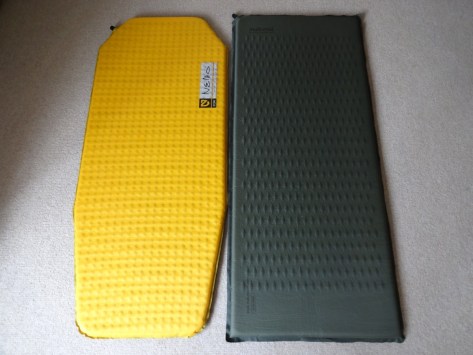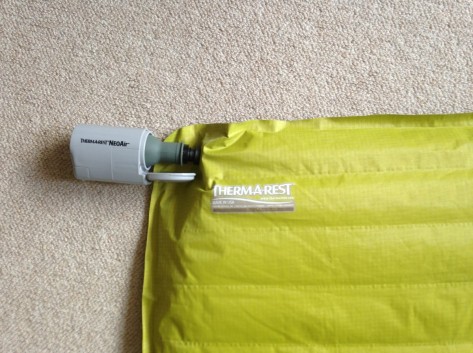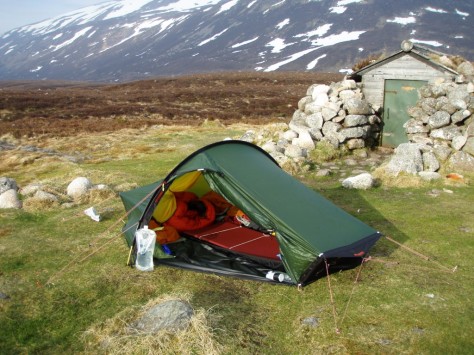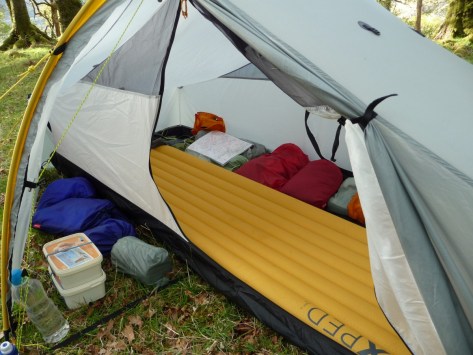As you may remember, on my Dartmoor trip, my Exped Synmat UL suffered a puncture on the last night. I returned it to the retailer, who forwarded it to the distributor to investigate. Last week it was returned to me, with the puncture repaired. As you can see from the picture below they’ve sealed it with some sealant and a patch. It seems to have done the trick and it stays inflated. However, the real test will be in the field.

While the failure was not catastrophic as I was carrying a 150cm thin foam pad, which serves as a back pad for my Mariposa rucksack, it would have been more than a bit annoying if it had entailed more nights sleeping with little padding or insulation. There’s no doubt that air mattresses have transformed comfort, but increasing numbers of users are reporting failures after only a few nights’ use.
It’s made me reassess whether I want to risk using an air mattress on longer walks. The alternative is to go back to the good old self inflating mattress, which seems to have a much lower failure rate. Even if it does fail, it still retains a level of insulation and cushioning that an air mattress can’t offer. Apart from a lower level of comfort, self inflating mattresses are generally a bit heavier and bulkier compared with an equivalent air mattress.
Amongst the numerous mattresses I own, I have a Multimat Superlite short mattress that was a free gift from a TGO Magazine subscription. It’s an old style rectangular one, weighing 360g. The newer version is shaped and the weight has been reduced to 320g.
The lightest self inflating mat in the market appears to be the Nemo Zor, which received a good write up from Roger Caffin on Backpackinglight.com. At £72, it can hardly be classed a bargain or cheap. However, it is usefully lighter, at an advertised 285g and because it has a double core construction, it is supposed to fold down smaller, so I took the plunge and bought one.


The thumbnails above (click to enlarge) show the relative sizes of the Multimat Superlite (left), Nemo Zor (middle) and a Thermarest NeoAir (right). They are all 120cm in length. As you can see from the pictures, the Multimat is the most bulky. The Zor is almost as compact as the the NeoAir. The weight of the Zor is slightly lower than advertised at 277g. The NeoAir is 259g. The new NeoAir short costs £95 (!!!!), so the Zor is better value, but the new Multimat at £43 is the best value by far.

The picture above shows the Zor (left) and the (old) Multimat Superlite side by side. The Zor seems to achieve a lighter weight through a higher density of perforations. Additionally, it has horizontal cores, which can’t be seen in the photo and the fabric seems to be slightly lighter. The face fabric is also more pleasant to the touch, feeling warmer and less slippery. On the underside, there are some anti slip silicone strips, shown below.

The inflation valve is also slightly different. Instead of twisting to close, the valve pushes down to seal and is then turned to lock. It’s a neat system and more convenient than the normal twist system.

In terms of comfort, the Zor is no different to the Multimat or indeed any other self inflating mat. It does feel warmer, but that could be a function of the facing material which has a slightly wrinkled appearance and feels softer. I’m not going to be able to make a judgement until I use it, which is now unlikely until spring next year. However, first impressions are good and it certainly compares well with an air bed in terms of weight and pack size.













